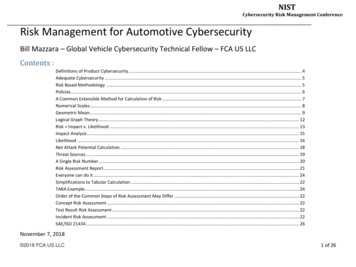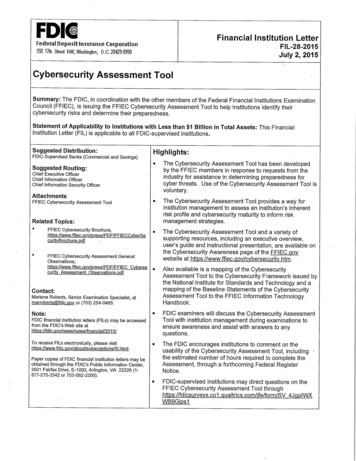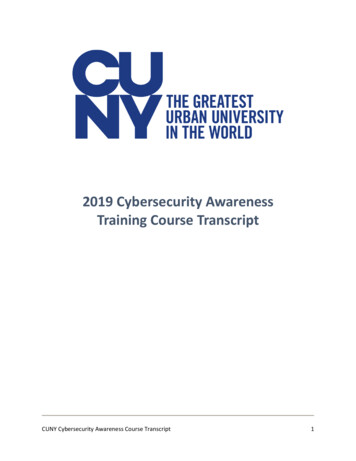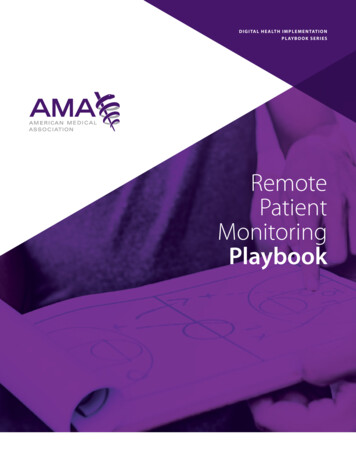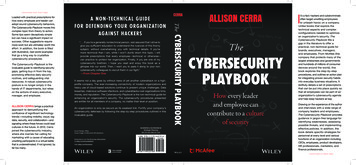
Transcription
(continued from front flap)ALLISON CERRA brings a practicalapproach to demystifying theconfluence of significant technologytrends—including mobility, cloud, bigdata, security, and collaboration—andsignaling where these forces could leadcultures in the future. In 2015, Cerrajoined the cybersecurity industry,where she marries her calling formarketing with a cause of educatingunwitting participants in a virtual battlethat is underestimated, if not ignored, byfar too many.“. . . If you’re a generally nontechnical person, rest assured that I strive togive you sufficient education to understand the nuances of this thornysubject, without overwhelming you with technical details. If you’remore technical than I am, while I won’t dumb down this topic, I willprovide prescriptions that every employee—technical or otherwise—can practice to protect her organization. Finally, if you are one of mycybersecurity brethren, I hope you read and enjoy this book as aglimpse into our world. Then, I want you to pass it along to your noncybersecurity colleagues to recruit them in our fight.”—From Chapter OneIt seems not a day goes by without news of yet another cyberattack on a highprofile company. The ever-increasing connectivity of modern organizations andheavy use of cloud-based solutions continue to present unique challenges. Databreaches, malicious software infections, and cyberattacks cost organizations time,money, and reputation. The Cybersecurity Playbook is the non-technical guide forenhancing an organization’s security. The cybersecurity procedures presentedare written for all members of a company, no matter their level or position.An organization is only as secure as its weakest link. Fortify your company’scybersecurity defenses by following the step-by-step procedures outlined in thisinvaluable guide.Cover Design: WileyCover Image: MicroOne/ShutterstockSubscribe to our free Business eNewsletterat wiley.com/enewslettersVisit wiley.com/businessBUSINESS & ECONOMICS/Strategic Planning 25.00 USA / 30.00 CANCYBERSECURITY PLAYBOOKThe Cybersecurity Playbook is theinvaluable guide to identifying securitygaps, getting buy-in from the top,promoting effective daily securityroutines, and safeguarding vitalresources. A robust cybersecurityposture is no longer simply in thehands of IT departments, but relieson the actions of every executive,manager, and employee.A NON -TECHNIC AL GUIDEFOR DEFENDING YOUR ORGANIZ ATIONAGAINST HACKERSCERRATheLoaded with practical prescriptions forhow every employee and leader canadopt sound cybersecurity behaviors,The Cybersecurity Playbook moves thiscomplex topic from theory to action.Some tips seem deceptively simplebut can have a significant impact onsuccess. Other suggestions requiremore work but are ultimately worth theeffort. In addition, the book is filledwith illustrative, real-world examplesthat go a long way to crystallizecybersecurity procedures.ALLISON CERRAIThird-Party RiskPhishingTheCYBERSECURITYPLAYBOOKTrojanHow every leaderand employee cancontribute to a cultureof security DDoS AttackStolen PasswordsZero-Day Exploitt’s a fact: hackers and cybercriminalsoften target unwitting employeesto unleash havoc on a company.Unlike books that explore thetechnical aspects and complexconfigurations needed to optimizean organization’s security, TheCybersecurity Playbook fills agap in the literature to offer apractical, non-technical guide forboards, executives, managers,and employees. From McAfee (thecompany that protects many of thelargest enterprises and governmentsand hundreds of millions of consumerdevices around the world), thisbook explores the step-by-stepprocedures, and outlines an action planfor integrating proven security habitsinto everyday business situations. Itskillfully details a set of prescriptionsthat can be put into place quickly sothat all employees can be part of anorganization’s cybersecurity agendaand help keep hackers at bay.Drawing on the experience of the authorand interviews with a wide range ofcompany leaders and employees,The Cybersecurity Playbook providesguidance in jargon-free language foridentifying weaknesses, assessingpossible threats, and implementingeffective policies. In addition, thebook details specific strategies forpersonnel at every level and variousfunctions of an organization includingCEOs, employees, product developers,HR professionals, marketers, andfinance professionals.(continued on back flap)
0.6875 inCERRATheCYBERSECURITY PLAYBOOKISBN 978-1-119-44219-6
TheCYBERSECURITYPLAYBOOKffirs i28 June 2019 1:57 PM
ffirs ii28 June 2019 1:57 PM
ALLISON CERRATheCYBERSECURITYPLAYBOOKHow every leaderand employee cancontribute to a cultureof securityffirs iii28 June 2019 1:57 PM
Copyright 2019 by McAfee LLC. All rights reserved.Published by John Wiley & Sons, Inc., Hoboken, New Jersey.Published simultaneously in Canada.“Mister Cellophane” (from Chicago)Words by Fred EbbMusic by John KanderCopyright 1975 (Renewed) Unichappell Music, Inc., and Kander & Ebb, Inc.All rights administered by Unichappell Music, Inc.All rights reservedUsed by permission of Alfred MusicNo part of this publication may be reproduced, stored in a retrieval system, or transmitted in anyform or by any means, electronic, mechanical, photocopying, recording, scanning, or otherwise,except as permitted under Section 107 or 108 of the 1976 United States Copyright Act, withouteither the prior written permission of the Publisher, or authorization through payment of theappropriate per-copy fee to the Copyright Clearance Center, Inc., 222 Rosewood Drive, Danvers,MA 01923, (978) 750–8400, fax (978) 646–8600, or on the Web at www.copyright.com. Requeststo the Publisher for permission should be addressed to the Permissions Department, John Wiley& Sons, Inc., 111 River Street, Hoboken, NJ 07030, (201) 748–6011, fax (201) 748–6008, or onlineat http://www.wiley.com/go/permissions.Limit of Liability/Disclaimer of Warranty: While the publisher and author have used their bestefforts in preparing this book, they make no representations or warranties with respect to theaccuracy or completeness of the contents of this book and specifically disclaim any implied warrantiesof merchantability or fitness for a particular purpose. No warranty may be created or extended bysales representatives or written sales materials. The advice and strategies contained herein may notbe suitable for your situation. You should consult with a professional where appropriate. Neither thepublisher nor author shall be liable for any loss of profit or any other commercial damages, includingbut not limited to special, incidental, consequential, or other damages.For general information on our other products and services or for technical support, pleasecontact our Customer Care Department within the United States at (800) 762–2974, outside theUnited States at (317) 572–3993 or fax (317) 572–4002.Wiley publishes in a variety of print and electronic formats and by print-on-demand. Somematerial included with standard print versions of this book may not be included in e-books or inprint-on-demand. If this book refers to media such as a CD or DVD that is not included in theversion you purchased, you may download this material at http://booksupport.wiley.com. Formore information about Wiley products, visit www.wiley.com.Library of Congress Cataloging-in-Publication Data:ISBN 9781119442196 (Hardcover)ISBN 9781119442165 (ePDF)ISBN 9781119442134 (ePub)Cover image: MicroOne/ShutterstockCover design: WileyPrinted in the United States of America10 9 8 7 6 5 4 3 2 1ffirsivv28 June 2019 1:57 PM
For Frank, the love of my life, who has yet to read a singlepage of anything I’ve written, including this one. Thank youfor loving me and keeping me grounded.ffirs v28 June 2019 1:57 PM
ffirs vi28 June 2019 1:57 PM
ContentsChapter 1Chapter 2Chapter 3Chapter 4The Time I Ruined Easter1Lessons Learned the Hard WayAdditional Lessons for YouWho Was at Fault?Remember This Crucial ElementWhy Me?Why You?W.I.S.D.O.M.8121415161719Mr./Ms. Cellophane23The New Kid on the BlockW.I.S.D.O.M. for the Board and CEOMaking Mr./Ms. Cellophane Visible263841“Good Morning, This Is YourWakeup Call.”47The Best DefenseW.I.S.D.O.M. for the Employee5459Stop the Line69The Internet of TerrorismW.I.S.D.O.M. for the Product Developer7480viiftoc vii19 June 2019 12:35 PM
viiiChapter 5Chapter 6Chapter 7Chapter 8Chapter 9CONTENTSBridging the Gap87When Too Much of a Good Thing Is BadIt Wasn’t Always This WayW.I.S.D.O.M. for HR Professionals909296Luck Favors the Prepared109BREACH!Preparing for BattleW.I.S.D.O.M. for theMarketer/Communicator112115Interesting Bedfellows127The More Things Change . . . . . the More They Stay the SameW.I.S.D.O.M. for the Finance Professional132137142Mr./Ms. Cellophane (Reprise)147A Picture Is Worth a Thousand WordsLetting Go to Hold OnAssuming the MantleW.I.S.D.O.M. for the CybersecurityProfessional149153156Experiencing a Culture of Security169Chapter 10 A Culture of Security for AllW.I.S.D.O.M. for the CEO/Board MemberW.I.S.D.O.M. for the EmployeeW.I.S.D.O.M. for the Product DeveloperW.I.S.D.O.M. for the HR ProfessionalW.I.S.D.O.M. for theMarketer/Communicatorftoc viii11915818719119119219219319 June 2019 12:35 PM
ixCONTENTSW.I.S.D.O.M. for the Finance ProfessionalW.I.S.D.O.M. for the CybersecurityProfessionalAcknowledgmentsAbout the AuthorIndexftocixx19419820120320519 June 2019 12:35 PM
ftoc x19 June 2019 12:35 PM
CHAPTER1The TimeI Ruined EasterI’ve had better Sundays.It was Easter, April 16, 2017. I had just finished ahomemade dinner with my husband. It was time to chill andfinally enjoy a few hours of downtime, compliments of thelatest binge-worthy craze on Netflix. Little did I know, I wasabout to star in my own real-life drama that was much morecringe-worthy instead.My cell lit up and I looked down at the display. It wasa text from Chatelle, our chief human resources officer(CHRO). Chatelle and I were close. We had just teamed upto help McAfee’s spinout from Intel as one of the world’slargest independent cybersecurity companies 12 days prior.Seeing a text from her on Easter wasn’t unusual, assuming it1c01 119 June 2019 1:10 PM
2THE CYBERSECURITY PLAYBOOKwas the type of well-wishing that happens between friendson a holiday. This was not that type of text.You need to check out our social media page. It’s bad.I immediately felt my blood pressure surge as I openedMcAfee’s company page on a very prominent social mediaplatform, the name of which I have redacted from this truestory. I was horrified.Someone had deliberately defaced the social profile of ournewly minted, 12-day-old company with the most obscene andoffensive language directed at nearly every walk of life. Thiswould be bad for any company. But let me try to express howdesperately bad this was for us.The offensive epithets were in stark contradiction to everything our company represented. We had just relaunched ourbrand with a new tagline, “Together is power,” reflecting our beliefthat it takes alll kinds to protect our world from cyber threats. Wehad just unveiled new values to all employees upon our company’slaunch, one of which espoused inclusivee candor and transparency.And we were a leader in cybersecurity. How would customers feelabout our ability to safeguard their most precious digital assets ifwe couldn’t even protect our own company’s profile on one of thelargest social media platforms? And, to top it off, my team—themarketing organization—was responsible for managing our company profile across all social channels, including the debased onestaring me in the face.I jumped into action. I had to get to the leader of ourdigital team to figure out what was going on. I reached herimmediately and didn’t even have to explain that the callwasn’t to wish her a Happy Easter.c01 219 June 2019 1:10 PM
The Time I Ruined Easter3“I know why you’re calling. We’re on it. Our account washacked. We’re talking to the [social media platform company] to get it resolved.”I started to think the worst. A hacked social media profile was one thing. What if this was a coordinated attackagainst McAfee with a much bigger prize at stake, with hackers diverting our attention to this fire drill while they seepedin through our company’s systems?She immediately reassured me that our chief information security officer (CISO) was already on the case, confirming our systems were good. Relief washed over me for amoment—until I realized I needed to make another call. OurCEO needed to know what was going on. And I preferred hehear the news from me. I was about to ruin his Easter Sunday. He picked up the phone almost instantly:“Chris, one of our social media accounts has been hacked.”His response was measured. “How bad is it?”“Our corporate servers are fine, Chris. It’s our corporatepage on a social media site that’s been hacked.”I explained to him just what had happened. Our socialmedia manager, Gavin, was the first to discover the attack.Gavin had been at home, doing what social media geeks doon holidays—he was online. Around 5 p.m. he saw a statusupdate on the social media platform with a bunch of randomletters in it. He figured someone on his team had butt-dialedthe update. Gavin deleted the random post.He then pinged his team to see who might have accidentally created that post. No one knew anything about it.c01 319 June 2019 1:10 PM
4THE CYBERSECURITY PLAYBOOKSoon, another meaningless post showed up. This was nownot random.Gavin logged into the social media platform and went tothe account settings area. All the names were familiar of thepeople who had administrative privileges for the account.Even so, to be on the safe side, Gavin started to delete allother admins.As he was doing that, his page refreshed, and Gavin waslocked out.There was now no doubt that this was malicious. In amoment, Gavin realized that his deleting the weird posts hadalerted the hacker that McAfee was aware of the defacement.It was like the classic race in tech crime dramas with fingers flying on keyboards, spinning icons as processes complete and messages flashing as only Hollywood can bringto the screen. Gavin and our hacker were racing online todo the same thing. Even without the pulsing soundtrack, thetension was every bit as fraught with drama. Gavin said, “Iwas trying to delete all the other admins, and the hacker wasdoing the same thing. He beat me.”Before I hung up with our CEO, I had one more pieceof disappointing news to share.“Oh and Chris, when you go to our social profile page,you’ll now see not just the offensive posts, but also ourcompany logo has been replaced with an image that lookslike a bird. Look closer. It’s not a bird at all. It’s. Um. It’sbody parts.”It’s common in the hacker community to deface siteswith obscene drawings to indicate that someone got “pwned,”c01 419 June 2019 1:10 PM
The Time I Ruined Easter5hacker slang for being defeated in a humiliating way—for being“owned.” Now that the hacker knew we were locked out and hewas in control for the time being, he added an obscene image toreplace our new company logo, just for good measure.My team frantically engaged the social media platformcompany to remediate the issue. But . . . things don’t happenquickly on holidays. And since this was now later in theevening, we were relegated to working with the company’sAsia-Pacific (APAC) group, making it seem as if time itselfhad to physically cross the ocean separating us and thesupport team. Minutes slowed to a crawl.We waited for what seemed like an eternity. Because itwas not our servers that were hacked, there was no big teamfrom McAfee I could put on the third-party problem to fixit. We could only check in with the company’s support teamevery few minutes, only to be told they were “on it.”After about 30 minutes, we received news that the socialmedia company had locked out alll admins from our company page, and only they had access now. That was the goodnews—at least no more damage would be done.The bad news? They did not have a means to simply rollback the page to what was there 30 minutes before. Theirprocedure was to lock the page, so no further changes couldbe made, and then to follow a validation and analysis procedure: For validation, they wanted to make sure that we werewho we said we were, and not a hacker calling up pretendingto be McAfee (How ironic!). Then the analysis part kickedin, where they wanted to study the extent of the hack beforetaking any further action.But what about the obscene image? It was still up on ourcorporate page. To make matters worse, the way this socialc01 519 June 2019 1:10 PM
6THE CYBERSECURITY PLAYBOOKmedia provider worked was that all employees who hadpersonal pages on this platform and who said they workedfor McAfee—their personal pages now sported the obsceneimage in place of our logo, too!Including mine.On the next update I received, the support team saidthey weren’t yet done with their “procedures.” They saidthe only way to roll back the page was first to reactivate theaccount—unlock it—and they were not going to do thatuntil they finished their security review.Seriously? How was this happening? Nothingg could bedone about our company page until they were done with theirreview. We were at their mercy. The most our employees coulddo was to delete any mention of McAfee on their own personalpages, which some who were aware of the event did.But that wasn’t sufficient. I continued to ruin EasterSunday for others as I alerted our executive team of theevent. We had ensured our company’s servers were safe, butthat didn’t mean McAfee wasn’t under attack through othersocial channels. And we certainly didn’t know whether ourown executive members—and their social profile personas—weren’t the next target.I took to email and group texts to sound the alarm,instructing our executive team to enable multifactor authentication on their personal profiles immediately on all socialnetworking sites (more on multifactor authentication in amoment).I followed my own advice and began frantically enablingthe security feature on my personal profile pages whereverI could, that is, until I hit a very popular social networking platform where I became stumped. I’m not sure if myc01 619 June 2019 1:10 PM
The Time I Ruined Easter7body was in the full throes of fight-or-flight (where the bodyredirects blood flow to major muscle groups to help oneflee a threat or stand ready to combat—in other words, notthe prefrontal cortex) or if the social media platform couldhave done a better job of not obscuring the safety capability. It was probably a bit of both. In either case, panic consumed me, and I resorted to a desperate measure: I deletedmy personal profile—and all its history—on the social mediaplatform altogether.An hour stretched to two, then three, then four. I wasregularly calling our CEO with the requisite, but annoying,status updates about our increasingly embarrassing vandalized company profile page. Calls that went something like:“Chris, we’re still working with them. They haven’t finishedtheir security review. We’re hoping it will be resolved in30 minutes.”Lather, rinse, repeat—every 30 minutes.It was on one of these calls that our CEO pulled a rabbitout of his hat.“Allison, I know of someone at the company and I’m tiredof waiting on them to take action. I’m calling him.”“Excellent, Chris. We’ll keep the heat on the APAC team inthe meantime.”Chris made the connection and pleaded our case. Within30 minutes of the call, the page was restored to its originalstate. I don’t know whether Chris’s call mattered, or whetherthe investigation simply had run its course and was completed. I just knew that the situation was now contained.c01 719 June 2019 1:10 PM
8THE CYBERSECURITY PLAYBOOKOn Monday morning, we posted an article on our intranetsite, letting every employee know what happened over theweekend. Remember that McAfee value I mentioned aboutpracticing inclusive candor and transparency? We owed it toour employees to explain what happened, especially giventheir social media pages were defaced over those tense fewhours when the heinous image replaced our company logo.Being candid and transparent is difficult when dealing withan uncomfortable topic. But it’s also necessary to truly livethe value. I tell you this story not just because it’s interesting, andnot just so you feel “Hey, better her than me!” I began withthis story because it’s a microcosm of what we’re going to betalking about for the rest of the book.Just so you get your money’s worth from this book—inthe very first chapter—I’ll now break down how the hackhappened, and what we did afterward. Most importantly Iwill lay out the steps that you can take tomorrow morningg atwork to see that this does not happen to you.Lessons Learned the Hard WayWhen we regained control of the account, we asked the socialmedia company to tell us whose admin account in our dashboard had been responsible for the changes.Turns out it was an employee with one of our mediaplacement agencies, who was no longer doing work forc01 819 June 2019 1:10 PM
The Time I Ruined Easter9us—let’s call her Julie. Her credentials were stolen by ateenager connected to a larger cybercrime syndicate. Juliemade the mistake so many others make: She didn’t practice good password hygiene. She used the same passwordto access multiple accounts, including her profile on thissocial media platform. And, since she was an authorizedadministrator for McAfee’s corporate page on the samesite, her personal credentials gave her access to not onlyher profile, but ours as well. When one of her accountswas compromised and her credentials traded on the DarkWeb, hackers simply tried the password across her otheronline accounts. That’s when they struck pay dirt inbreaking Julie’s administrative access to McAfee’s company profile on the social media platform. The rest waschild’s play.Hindsight is 20/20 and this case was no exception. Vulnerability number one: Julie used the same password foraccesss to her social media account (and our corporate pageon the same social media platform as one of our authorizedadministrators) as she used for other accounts. If she hadused unique passwords, then the credentials that bad actorsbought on the Dark Web would have been worthless. What’sworse? When alerted to the hack on her personal account,Julie quickly changed her password. But she failed to changeit across her other accounts, including the one in this story.That’s on her.Vulnerability number two: We should have requiredmultifactor authentication for all admins on that socialmedia site. What this means is you can gain access to asystem not only if you have the correct password, but youmust also be able to enter a one-time code that’s generatedc01919 June 2019 1:10 PM
10THE CYBERSECURITY PLAYBOOKand sent to, say, your phone. If you don’t have the codewithin a few seconds or minutes of being asked for it,you’re not getting in. There are several versions of thistype of authentication and I’m simplifying it here, but youget the idea. That’s on us.Vulnerability number three: We did not do a reviewfrequently enough to see who no longer needed accesss toour account. Julie helped us a while ago, but we shouldhave removed her from being an admin after her activityhad ended. We still could have been hacked while she wasactively working with us, but our lack of access hygiene justmade it worse. That’s definitely on us.All of these actions would have vastly reduced thechances of the hack occurring. But let’s say for some crazyreason a hacker with enough motivation, skill, and luck wasable to get into our social media account. Let’s look at whatcould have helped us after a hack was discovered, had we putcertain things into place beforehand.We should have had a procedure where we lock out alladmins without letting on that we are aware of the attack.By our deleting the nonsense posts, we alerted the hacker.Then when the hacker saw we were deleting permissions, heacted more quickly than we did.It was fortunate that Gavin was on the defaced page onEaster Sunday. Otherwise we may not have known as quicklyabout the defacement. Now we have a tool that uses machinelearning to detect unusual images, profanity, slurs, and otheranomalous material on social media sites. It immediatelyalertss several members of our team in the event it detectssuch unusual activity.c011019 June 2019 1:10 PM
The Time I Ruined Easter11Note: I’m not going to name the tools we use for tworeasons: First, tools come and go, and they also tend tohave different effectiveness at different times. In otherwords, when a tool is first launched, it may be highlyeffective—until hackers figure a way around it. Because Idon’t know when you’re reading this book, I don’t wantto praise something that I may no longer be using whenyou’re actually reading these words.The second reason for not mentioning the tool isMcAfee already is a huge bullseye for hackers aroundthe world. By keeping them guessing what exact tools weuse, we help to lessen that threat. If you search for someof the descriptions I use for tools, you’ll quickly find current ones you can try.Back to the story of lessons we learned:At the time we alerted the social media company of thehack, we did not know their procedures for dealing with it.Mistake. We found out only then that their policy was tofreeze the account for many hours, regardless of how defacedour page was. We now ask about these procedures in advanceof creating corporate pages on other sites.We learned the hard way that money talks. Becausewe were spending a decent amount of money on advertising on this social media site via agencies, we looked like asmaller account to the company than we were; that mighthave affected response levels. Today, we spend directly withsocial media platformss to accurately reflect our investmentand receive the commensurate service levels we deserve.c011119 June 2019 1:10 PM
12THE CYBERSECURITY PLAYBOOKAnd, we learned that third-party companies with whichwe do business may not have strong security practices. Thisis especially important to remember for companies thathave access to your systems or appear as an extension ofyour organization. In particular, smaller third-party companies with which you have a relationship may not haveformal IT and security teams, let alone practice rigorouscybersecurity hygiene.Finally, the postmortem of that Easter’s unfortunateevents delivered one final punch in the gut. McAfee wasn’teven a deliberate target in the hack. The hacker didn’t realize Julie was an administrator for McAfee when he brokeher credentials. He didn’t know (or care) who Julie was. Hewas on the hunt for passwords. His reward would come onlyafter he determined what the password unlocked—be it apersonal banking account, a company’s network, or something else. Once he found one that just so happened to unlockthe keys to McAfee’s company page on that social network,he unleashed his rants of abuse on it, offending everyone hecould and humiliating us in the process. Even for hackers, sometimes it’s better to be lucky than good.Additional Lessons for YouHave lists of people you can call and people to whom youcan escalate. Have them where you and your team can accessthem anytime. Also, the lists must not only be for people onyour team but also for people at the vendors for your website,social media, cloud storage, etc.c011219 June 2019 1:10 PM
The Time I Ruined Easter13It needs to be in someone’s job description toregularly review who has access to an account and cleanup the list to remove people who no longer work on thoseprojects.Use multifactor authentication. For some systems we can automatically detect if one of our users hasit turned on, and the system will tell us if a user turns itoff, even for a few minutes as she switches to a new computer, for example. With systems over which we have lessdirect control, like a cloud-based service, we require thatusers send us screenshots of the multifactor authentication being enabled.You can imagine that we scrutinize social media outletsnow before we put a page up. In addition to the measures Idescribed above, we ask the following:c0113 How do you handle any personally identifiableinformation? What technology are you using? (We take the answersand do a vulnerability assessment.) How does your access management system work? What third-party tools are allowed to connect to yourplatform to automate any rollback of content that is necessary after a hack? What is your escalation process if an account is takenover? What’s your service level agreement for responding toa hack and for getting a customer back to the pre-hackcontent?19 June 2019 1:10 PM
14THE CYBERSECURITY PLAYBOOKWho Was at Fault?Certainly, the social media provider can make the case that wedidn’t do some obvious things like keeping admins to a minimum by reviewing them often, insisting upon unique, strongpasswords, and so forth. But it didn’t help that they had sucha rigid policy that even an obvious, egregious hack to a sitehad to remain in place until “analysis” was complete. And ofcourse, the agency person should have not reused the samepassword across multiple accounts.But notice that I titled this chapter “The Time I RuinedEaster.” No, I didn’t hack McAfee’s corporate social page. Ididn’t knowingly leave the door open for a bad actor to dothe same. And there was nothing I wanted lesss on that EasterSunday than to be dealing with a situation that resulted froma comedy and confluence of errors across multiple fronts. Allthat said, I can only take responsibility for its occurrence.Because, at the end of the day, that corporate social pagewas under my team’s watch. And we failed to take reasonablemeasures to uphold our duty in safeguarding it.Personal responsibility is an uncomfortable thing. Veryfew of us relish the thought of examining what we could havedon
The Cybersecurity Playbook moves this complex topic from theory to action. Some tips seem deceptively simple but can have a significant impact on success. Other suggestions require more work but are ultimately worth the effort. In addition, the book is filled with illustrative, real-world examples that go a long way to crystallize



